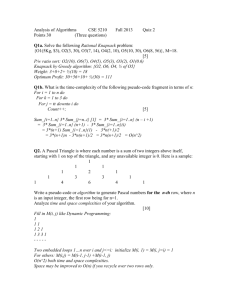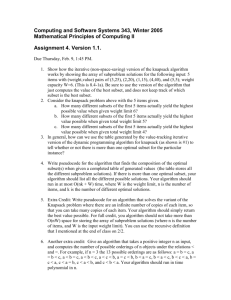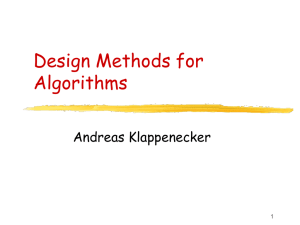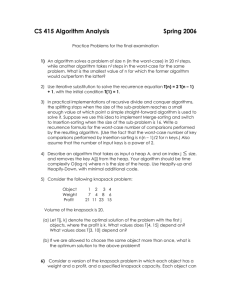E(I, j ) = min{1+E(i -1, j ), 1 + E(i, j-1), diff(i, j ) + E(i -1, j-1)}
advertisement
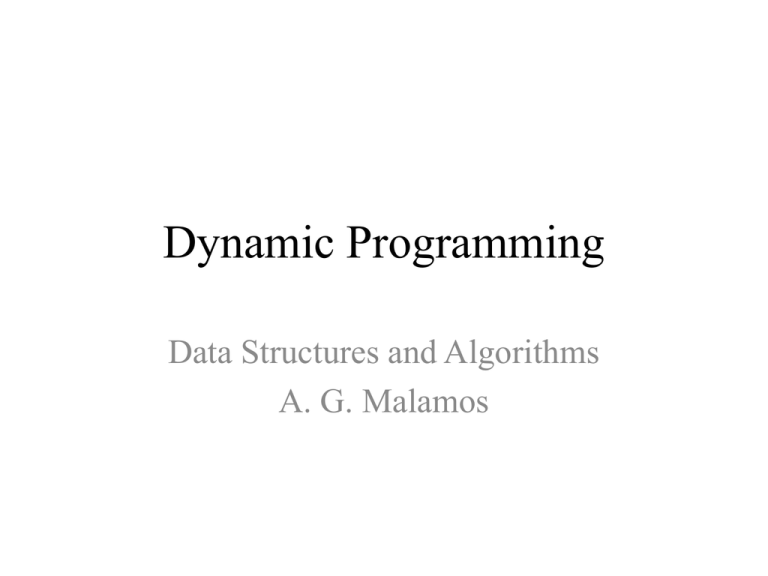
Dynamic Programming
Data Structures and Algorithms
A. G. Malamos
Introduction
The two sledgehammers of the algorithms craft are dynamic programming and linear
programming. Both are techniques of very broad applicability that can be invoked when
more specialized methods fail.
Shortest paths in dags
The special distinguishing feature of a dag (Directed Acyclic Graph) is that its nodes
can be linearized; that is, they can be arranged on a line so that all edges go from left
to right.
A similar relation can be written for every node. If we compute these dist values in
the left-to-right order of dag, we can always be sure that by the time we get to a
node v, we already have all the information we need to compute dist(v). We are
therefore able to compute all distances from S in a single pass.
Dynamic Programming (the idea)
Dynamic programming is a very powerful algorithmic paradigm in which a problem is
solved by identifying a collection of subproblems and tackling them one by one,
smallest first, using the answers to small problems to help figure out larger ones, until
the whole lot of them is solved. In dynamic programming we are not given a dag; the
dag is implicit. Its nodes are the subproblems we define, and its edges are the
dependencies between the subproblems: if to solve subproblem B we need the answer to
subproblem A, then there is a (conceptual) edge from A to B. In this case, A is thought
of as a smaller subproblem than B —
and it will always be smaller , in an obvious sense.
Longest increasing subsequences
Longest increasing subsequences
Arrows point only
to neighbors with
higher value
Longest increasing subsequences
There is an ordering on the subproblems, and a relation that shows how
to solve a subproblem given the answers to “smaller”subproblems, that is,
subproblems that appear earlier in the ordering.
Edit distance
When a spell checker encounters a possible misspelling, it looks in its dictionary for
other words that are close by . What is the appropriate notion of closeness in this
case?
A natural measure of the distance between two strings is the extent to which they can
be aligned, or matched up. Technically , an alignment is simply a way of writing the
strings one above the other .
Edit distance is so named because it can also be thought of as the minimum number
of edits —
insertions, deletions, and substitutions of characters—
needed to transform
the first string into the second. For instance, the alignment shown on the left
corresponds to three edits: insert U, substitute O ! N, and delete W.
Edit Distance
When solving a problem by dynamic programming, the most crucial question is, What
are the subproblems?
There is an ordering on the subproblems, and a relation that shows how to solve
a subproblem given the answers to “smaller”subproblems, that is, subproblems
that appear earlier in the ordering.
Our goal is to find the edit distance between two strings x[1,..,m] and y[1,..,n]. What
is a good subproblem? Well, it should go part of the way toward solving the whole
problem
Looking at the edit distance between some prefix of the first string, x[1,.., i], and
some prefix of the second, y[1,..,j ]? Call this subproblem E(i, j ) Our final
objective, then, will be to compute E(m, n).
Edit Distance
For this to work, we need to somehow express E(i, j ) in terms of smaller subproblems.
Let's see —
what do we know about the best alignment between x[1,..,i] and y[1,..,j ]?
Well, its rightmost column can only be one of three things:
The first case incurs a cost of 1 for this particular column (delete a character x[i]),
and it remains to align x[1,..,i -1] with y[1,..,j ]. But this is exactly the subproblem
E(i -1, j ).
In the second case, also with cost 1, we still need to align x[1,...,i] with y[1,..,j-1].
This is again another subproblem, E(i; j-1). And in the final case, which either costs
1 (if x[i] <> y[j]) or 0 (if x[i] = y[j ]), what's left is the subproblem E(i-1, j-1).
Edit Distance
In short, we have expressed E(i, j ) in terms of three smaller subproblems E(i -1, j ), E(I,
j -1), E(i-1; j -1). We have no idea which of them is the right one, so we need to try them
all and pick the best:
E(I, j ) = min{1+E(i -1, j ), 1 + E(i, j-1), diff(i, j ) + E(i -1, j-1)}
where for convenience diff(i, j ) is defined to be 0 if x[i] = y[j] and 1 otherwise
For instance, in computing the edit distance between EXPONENTIAL and
POLYNOMIAL, subproblem E(4, 3) corresponds to the prefixes EXPO and POL. The
rightmost column of their best alignment must be one of the following:
Thus, E(4; 3) = min{1 + E(3,3), 1 + E(4,2), 1 + E(3,2)}
Edit Distance
The answers to all the subproblems E(i, j) form a two-dimensional table
In what order should these subproblems be solved? Any order is fine, as long as E(i-1,j),
E(i, j-1), and E(i-1, j-1) are handled before E(i, j ). For instance, we could fill in the
table one row at a time, from top row to bottom row , and moving left to right across
each row . Or alternatively , we could fill it in column by column. Both methods would
ensure that by the time we get around to computing a particular table entry , all the other
entries we need are already filled in.
Edit Distance
There just remain the “base cases”of the dynamic programming, the very smallest
subproblems. In the present situation, these are E(0, _) and E(_, 0), both of which are
easily solved. E(0, j ) is the edit distance between the 0-length prefix of x, namely the
empty string, and the first j letters of y: clearly j . And similarly , E(i, 0) = i.
for i = 0 to m
E(i, 0) = i
for j = 1 to n
E(0. j ) = j
for i = 1 to m
for j = 1 to n
E(i; j ) = min{E(i-1, j ) + 1, E(i, j-1) + 1, E(i-1, j-1) + diff(i;,j )}
return E(m, n)
And in our example, the edit distance turns out to be 6
The dag
knapsack
During a robbery!!!, a burglar finds much more loot than he had expected and has to
decide what to take. His bag (or “knapsack”) will hold a total weight of at most W pounds.
There are n items to pick from, of weight w1,..,wn,. and dollar value v1,..,vn
What's the most valuable combination of items he can into his bag?
For instance, take W = 10 and
There are two versions of this problem. If there are unlimited quantities of each item
available, the optimal choice is to pick item 1 and two of item 4 (total: $48). On the
other hand, if there is one of each item (the burglar has broken into an art gallery ,
say), then the optimal knapsack contains items 1 and 3 (total: $46)
Intercalation from Greedy
The Fractional Knapsack problem
Intercalation from Greedy (Fractional
Knapsack)
Fractional knapsack problem:
n items.
Item i worth vi, weighs wi pounds.
• Find a most valuable subset of items with total weight≤W.
Fractional knapsack means you can take fraction of an item – assume items are in
granular form.
Greedy solution
To solve the fractional problem, rank items by value/weight:vi/wi
Intercalation from Greedy (Fractional
knapsack)
Let vi/wi ≥vi+1/wi+1 for all i
FRACTIONAL-KNAPSACK(v, w,W)
load ←0
i ←1
While load <W and i ≤n
do if wi ≤W−load
Then take all of item i
else take(W−load)/wi of item i
add what was taken to load
i ←i +1
Time:O(nlogn) to sort, O(n)thereafter.
Greedy doesn’t work for the 0-1 knapsack problem. Might get empty space, which
lowers the average value per kilo of the items taken.
Intercalation from Greedy (1/0
Knapsack)
Greedy doesn’t work here, we need Dynamic Programming
Now Back to Dynamic
Programming
Knapsack with or without repetitions
Knapsack with repetition
As always, the main question in dynamic programming is, what are the subproblems?
In this case we can shrink the original problem in two ways: we can either look at
smaller knapsack capacities w<= W , or we can look at fewer items (for instance,
items 1, 2,..,j , for j<=n). It usually takes a little experimentation to figure out exactly
what works.
The first restriction calls for smaller capacities. Accordingly , define
K(w) = maximum value achievable with a knapsack of capacity w
Can we express this in terms of smaller subproblems? Well, if the optimal solution to
K(w) includes item i, then removing this item from the knapsack leaves an optimal
solution to K(w-wi). In other words, K(w) is simply K(w-wi) + vi, for some i. We
don't know which i, so we need to try all possibilities.
Knapsack with repetition
This algorithm fills in a one-dimensional table of length W + 1, in left-to-right order .
Each entry can take up to O(n) time to compute, so the overall running time is O(nW ).
Knapsack without repetition
On to the second variant: what if repetitions are not allowed? Our earlier subproblems
now become completely useless. For instance, knowing that the value K(w-wn) is very
high doesn't help us, because we don't know whether or not item n already got used up
in this partial solution. We must therefore refine our concept of a subproblem to carry
additional information about the items being used. We add a second parameter ,
0<=j<=n.
K(w, j ) = maximum value achievable using a knapsack of capacity w and items 1,..,j
The answer we seek is K(W, n)
How can we express a subproblem K(w, j ) in terms of smaller subproblems?
Knapsack problem
Shall I pick j-th
item or not?
The algorithm then consists of filing out a two-dimensional table, with W + 1 rows
and n + 1 columns. Each table entry takes just constant time, so even though the
table is much larger than in the previous case, the running time remains the same,
O(nW ).
Neither version of this problem is likely to have a polynomial-time algorithm.
However , using dynamic programming they can both be solved in O(nW ) time,
which is reasonable when W is small, but is not polynomial.
Algorithms, 2006, S. Dasgupta, C. H. Papadimitriou, and U . V . Vazirani
Assignment 4 for the next 2 weeks
k Shortest Path
Suppose then that we are given a graph G with lengths on the edges, along with two
nodes s and t and an integer k, and we want the shortest path from s to t that uses at
most k edges.
In dynamic programming, the trick is to choose subproblems so that all vital
information is remembered and carried forward.
In this case, for each vertex v and each integer i<=k, dist(v, i) to be the length of the
shortest path from s to v that uses i edges. The starting values dist(v; 0) are 1 for all
vertices except s, for which it is 0.
For i<=k:
Most Reliable Route
Assume someone is driving from home to work everyday. Assume that before to
leave home he gets from the internet the traffic jam probability of every root in the
direction to his work. The problem is to find the most reliable root, the one with the
maximum probability to avoid traffic jam.
0,6
0,4
6
7
2
0,5
9
0,4
1
0,7
0,5
5
0,5
3
0,4
0,6
0,2
0,9
8
4
0,7
Most Reliable Root
Let R be the set of all roots from node 1 to node 9.
Let r ∈ P be a root.
Let L ∈ p denote that link L belongs in a path p.
Let in each L to be assigned probability p NOT to be involved in a traffic jam
The maximum reliable route is the following problem
Maxr ΠL pL
If we assume logarithm of the objective function
Ln(Maxp ΠL wL)=Maxp {ΣL ln(wL)}=minp {ΣL--ln(wL)}
All-pairs shortest paths
What if we want to find the shortest path not just between s and t but between all
pairs of vertices?
Is there is a good subproblem for computing distances between all pairs of vertices
in a graph? Simply solving the problem for more and more pairs or starting points is
leads to complexity:
One idea comes to mind: the shortest path u – w1-….- v between u and v
uses some number of intermediate nodes—
(possibly none). Suppose we disallow
intermediate nodes altogether .
Then we can solve all-pairs shortest paths at once: the shortest path from u to v is
simply the direct edge (u,v), if it exists. What if we now gradually expand the set of
permissible intermediate nodes?
All pair shortest path
All pairs shortest paths
The traveling salesman problem
A traveling salesman is getting ready for a big sales tour . Starting at his hometown,
suitcase in hand, he will conduct a journey in which each of his target cities is visited
exactly once before he returns home. Given the pairwise distances between cities,
what is the best order in which to visit them, so as to minimize the overall distance
traveled?
Denote the cities by 1,..,n, the salesman's hometown being 1, and let D = (dij) be the
matrix of intercity distances. The goal is to design a tour that starts and ends at 1,
includes all other cities exactly once, and has minimum total length.
TSP
Even in this tiny example, it is tricky for a human to find the solution; imagine what
happens when hundreds of cities are involved.
It turns out this problem is also difficult for computers. In fact, the traveling salesman
problem (TSP) is one of the most notorious computational tasks. There is a long history
of attempts at solving it, a long saga of failures and partial successes, and along the way
, major advances in algorithms and complexity theory . The most basic piece of bad
news about the TSP , which we will better understand in Chapter 8, is that it is highly
unlikely to be solvable in polynomial time.
The brute-force approach is to evaluate every possible tour and return the best one.
Since there are (n-1)! possibilities, this strategy takes O(n!) time.
We will now see that dynamic programming yields a much faster solution, though not
a polynomial one.
TSP
Subproblems refer to partial solutions, and in this case the most obvious partial solution
is the initial portion of a tour . Suppose we have started at city 1 as required, have
visited a few cities, and are now in city j .
What information do we need in order to extend this partial tour?
We certainly need to know j , since this will determine which cities are most convenient
to visit next. And we also need to know all the cities visited so far , so that we don't
repeat any of them.
TSP
TSP complexity
In order to prove our superiority in complexity we have to prove that n!>2^n
If n > 4, assume n! > 2^n, and try to get to (n+1)! > 2^(n+1)
Proof
( n+1)!=n! (n+1)
from the inductive hypothesis we have
n! (n+1) > 2^n (n+1)
since n>1 we have
2^n(n+1) > 2^n(2) and
2^n(2) = 2^{n+1}
so now……:
(n+1)!=n! (n+1) > 2^n(n+1) > 2^n(2) =2^{n+1}
(n+1)! > 2^{n+1}
Independent sets in trees
A subset of nodes is
edges between them.
an independent set of graph G = (V,E) if there are no
the nodes {1,5} form an independent set, but nodes {1,4,5} do not, because of the
edge between 4 and 5. The largest independent set is {2,3,6}.
Independent sets in trees
Like several other problems we have seen in this chapter (knapsack, traveling
salesman), finding the largest independent set in a graph is believed to be intractable.
However , when the graph happens to be a tree, the problem can be solved in linear
time, using dynamic programming.
So here's the algorithm: Start by rooting the tree at any node r. Now , each node
defines a subtree—
the one hanging from it. This immediately suggests subproblems:
I (u) = size of largest independent set of subtree hanging from u:
The goal is I(r).
Dynamic programming proceeds as always from smaller subproblems to larger ones,
that is to say , bottom-up in the rooted tree. Suppose we know the largest independent
sets for all subtrees below a certain node u; in other words, suppose we know I (w) for
all descendants w of u. How can we compute I (u)? Let's split the computation into two
cases: any independent set either includes u or it doesn't
Independent sets in trees
If the independent set includes u, then we get one point for it, but we aren't
allowed to include the children of u —
therefore we move on to the grandchildren
(their children are connected to u thus could not be in the independent set). This
is the first case in the formula. On the other hand, if we don't include u, then we
don't get a point for it, but we can move on to its children.
The number of subproblems is exactly the number of vertices. With a little care,
the running time can be made linear , O(V + E).
